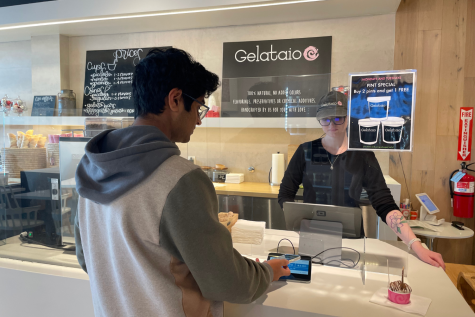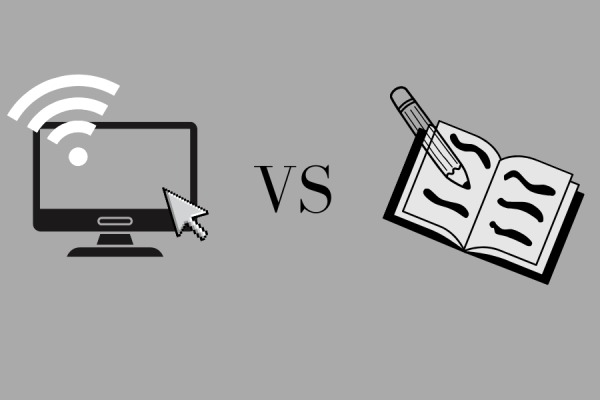Touchless payments are taking over
Behind the scenes of the new trendy way to pay
Touchless payments are accepted at businesses all over the globe, both at the register and the drive-thru.
March 22, 2023
Double-click to pay. Just hold your phone near the reader, and the transaction is complete. Seems pretty simple. But what about the technology behind it?
“Faster and easier than using cards and cash.” This is one of the multiple messages displayed on Apple’s website advertising their unique feature of Apple Pay.
The slogan lives up to its promise. Many people are guilty of being reliant on their mobile wallets, especially teenagers. Lots don’t even carry cash anymore.
I use Apple Pay to buy food and basically everything else, it’s all I use.
— Leo Leckey
“I use Apple Pay to buy food and basically everything else, it’s all I use,” said Leo Leckey, a sophomore at Carlmont High School.
Wallets were developed in the 1600s as an easy way of storing paper currency. They’ve remained prominent in society for a long time, and are still in use today.
Except that number has started to decrease over the years. As technology evolved, physical wallets met their match. They were suddenly a bulky burden, and people turned to new solutions. We take our phones everywhere, so why not use them to pay?
A press release by Juniper Research revealed that the number of virtual card transactions will globally exceed 121 billion by 2027, a 340% increase from 2022. The study identified virtual cards as a key market driver of contactless payments, and many would agree. Especially in these times, mobile payments are certainly the most convenient.
“I always have my phone on me, so Apple Pay is the easiest,” Leckey said.
With the number of customers becoming reliant on touchless payment methods increasing, businesses are adapting to the trend.
Various retailers provide options for contactless payment: on pin pads in-store using modern readers such as Square and Shopify, or through online ordering compatible with Paypal and Venmo.
Teenagers are one of the leading age groups using mobile payments. Delfina Bianchi, a junior at Carlmont High School, relies on Apple Pay for the majority of her transactions.
“I never bring cash with me because I’d much rather carry around my phone than worry about carrying around credit cards and cash. It’s much quicker, and it’s easier access to money,” Bianchi said.
In particular, the trend of touchless payments continued to grow when COVID-19 hit. Many became more conscious of the germs transferred through cash and numerous businesses stopped accepting it. Now, several stores only allow cards or contactless payments.
According to Pew Research Center, about four-in-ten Americans say none of their purchases in a typical week are paid for using cash. Additionally, some think this statistic should be higher.
“Cash is harder to find and most people carry their phones on them, which means that they can pay more easily,” Bianchi said.
Secure card information
It is often the case that those of older generations worry about the security of Apple and Google Pay, while the younger generations don’t.
“I think that Apple Pay is pretty safe since there are no card numbers,” Bianchi said. “I trust the products and the process.”
Although it isn’t a worry for some, no worries are necessary. Both methods of touchless payment are incredibly secure and use different systems such as encryption and tokenization.
A user’s card details are provided only once in both services, during the initial setup. However, Google actually stores your information while Apple is merely the messenger.
I think that Apple Pay is pretty safe, since there are no card numbers. I trust the products and the process.
— Delfina Bianchi
When a card is added to a user’s Apple Wallet, they send the information to its issuing bank. The bank replaces the card details with a device and card-specific token known as the Device Account Number (DAN).
A DAN structurally resembles a credit card number and is used to pass information through various wireless networks without the actual card details being exposed. The number is stored on a user’s device so it can’t be extracted into anything valuable to fraudsters. The actual bank account number is held safe in a secure, online token vault.
In short, the card data is encrypted at its origin, Apple Wallet, and passed through systems until decrypted at its end destination, the merchant.
This process requires the company to negotiate deals with banks to get them to sign up for its service. It limits the number of cards that are compatible with Apple Pay, although not by much.
Google Pay, however, is different. When a card is set up, Google Pay issues a virtual card to the device for each card that is put in. Google then takes the information and stores it in its secure servers while replacing the virtual card with its own generated algorithm.
This is a benefit for Google Pay users, as it allows you to store whatever type of card you’d like, and it doesn’t have to be connected to a bank, so a gift card or loyalty card would work as well.
When a customer uses Google Pay, they’re paying with a virtual card that their device transmits using the previously mentioned NFC technology. After the Google Pay virtual card gets charged by the merchant, Google copies the details of the transaction and charges the stored card itself. This way, the seller never sees the real card.
Benefits for businesses
There are multiple ways a business can accept touchless payments. All you need is a compatible reader, and you’re good to go. The hard part is deciding which system to choose.
Companies such as Square and Shopify offer contactless reader options, as well as other business tools such as inventory tracking and online store sites.
Christianne Mares opened Gelataio 8 years ago in downtown San Carlos, California, and has been using her Square system since the beginning. The gelato shop has consistently taken both cash and card, but things changed in 2020.

“Before the pandemic, I would say it was half-half but then nobody wanted to handle money. For a while, it was zero cash and now it’s getting back, maybe a third or a fourth of people pay with cash, and the rest with a credit card,” Mares said.
For Mares, the biggest benefit of the card reader is convenience.
“Handling cash, it’s a lot of work, Square reduces a lot of employee time counting money, making sure everything’s correct. It’s also time in the sense that I don’t need to go as often to the bank to make deposits,” Mares said. “And it’s safer not having as much cash in the store.”
Although the ability to accept touchless payments decreases the time spent on transactions, it increases the risk of losing profit. With every transaction, Square takes 2.6% + 10 cents out of the profit, which led Gelataio to adjust its prices accordingly.
Another downside Mares struggles with is contacting customer support.
“It’s very difficult to contact somebody if you have trouble, getting troubleshooting is almost impossible,” Mares said.
When White Sage Boutique started in July 2021, co-owner Sofia Kurt knew exactly what company she wanted to use: Shopify.
“I love shopping online, I think everyone did that a bit more during COVID, and I always saw at the bottom of most stores, it said ‘Powered by Shopify,’ so I kind of just kept that in the back of my head,” Kurt said.
Everyone’s getting those cards that have tap, so they tend to do that more than inserting a card.
— Sofia Kurt
White Sage uses Shopify’s app in conjunction with its card reader to easily accept and process payments. The app helps to record transactions and works with the card reader to charge customers. Once the payment goes through, it gets transferred to Shopify, which deposits the money into a business bank account every few weeks.
One of the biggest benefits of Shopify is that it can be taken it on the go, as long as you have the app and a card reader. The only inconvenience is that it requires Wi-Fi to function.
“If we’re having a pop-up, we just take our iPad and the card reader. But if the Wi-Fi is down, it’s not a good time,” Kurt said.
Another benefit is that the card readers used in many businesses are compatible with just about anything. Whether on an EMV chip or through a mobile device, White Sage takes it all.
“Everyone’s getting those cards that have tap, so they tend to do that more than inserting a card,” Kurt said.
Overall, it’s clear that touchless payments are a trend that isn’t going away anytime soon. The ability to accept all payments is extremely beneficial to any business. After all, not everyone keeps their wallets on them, but they always have their phones.
“Sometimes people are just on a walk and they pop in. People love using their Apple Watch and they’re like, ‘Oh, do you take Apple Pay?’” Kurt said. “We profit more from it.”
This story was originally published on Scot Scoop News on March 20, 2023.




























![IN THE SPOTLIGHT: Junior Zalie Mann performs “I Love to Cry at Weddings,” an ensemble piece from the fall musical Sweet Charity, to prospective students during the Fine Arts Showcase on Wednesday, Nov. 8. The showcase is a compilation of performances and demonstrations from each fine arts strand offered at McCallum. This show is put on so that prospective students can see if they are interested in joining an academy or major.
Sweet Charity originally ran the weekends of Sept. 28 and Oct. 8, but made a comeback for the Fine Arts Showcase.
“[Being at the front in the spotlight] is my favorite part of the whole dance, so I was super happy to be on stage performing and smiling at the audience,” Mann said.
Mann performed in both the musical theatre performance and dance excerpt “Ethereal,” a contemporary piece choreographed by the new dance director Terrance Carson, in the showcase. With also being a dance ambassador, Mann got to talk about what MAC dance is, her experience and answer any questions the aspiring arts majors and their parents may have.
Caption by Maya Tackett.](https://bestofsno.com/wp-content/uploads/2024/02/53321803427_47cd17fe70_o-1-1200x800.jpg)
![SPREADING THE JOY: Sophomore Chim Becker poses with sophomores Cozbi Sims and Lou Davidson while manning a table at the Hispanic Heritage treat day during lunch of Sept 28. Becker is a part of the students of color alliance, who put together the activity to raise money for their club.
“It [the stand] was really fun because McCallum has a lot of latino kids,” Becker said. “And I think it was nice that I could share the stuff that I usually just have at home with people who have never tried it before.”
Becker recognizes the importance of celebrating Hispanic heritage at Mac.
“I think its important to celebrate,” Becker said. “Because our culture is awesome and super cool, and everybody should be able to learn about other cultures of the world.”
Caption by JoJo Barnard.](https://bestofsno.com/wp-content/uploads/2024/01/53221601352_4127a81c41_o-1200x675.jpg)















